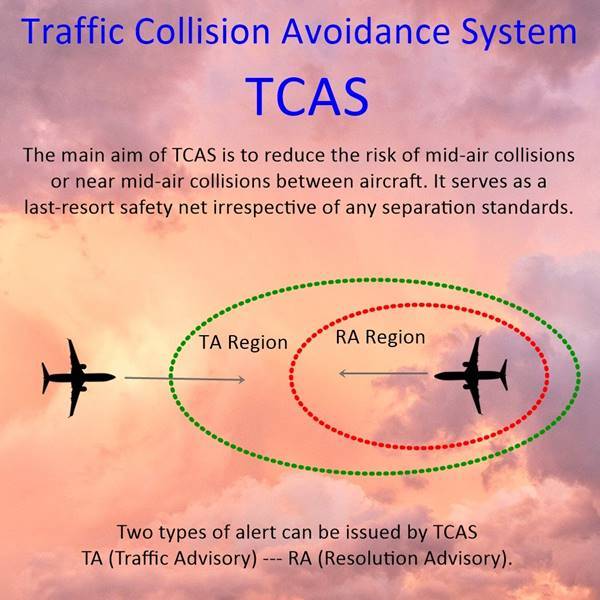Traffic Collision Avoidance System (TCAS): A Comprehensive Overview
The Traffic Collision Avoidance System (TCAS), also known as the Airborne Collision Avoidance System (ACAS), is a critical safety technology for aviation. It is designed to prevent mid-air collisions between aircraft by providing real-time warnings to pilots. TCAS functions independently of ground-based Air Traffic Control (ATC), using data exchanged between aircraft through onboard transponders (Federal Aviation Administration, Wikipedia).
Understanding ACAS and TCAS: Key Differences Explained
ACAS (Airborne Collision Avoidance System) is a global standard defined by the International Civil Aviation Organization (ICAO) that outlines the requirements for airborne systems designed to prevent mid-air collisions. TCAS (Traffic Collision Avoidance System) is a specific implementation of these requirements, widely used in commercial aviation. TCAS, particularly TCAS II, meets the standards of ACAS II and provides both Traffic Advisories (TAs) and Resolution Advisories (RAs) to pilots. While ACAS is the broader category that includes newer systems like ACAS X for advanced safety and unmanned aircraft, TCAS is the most recognized and used system in this category. The key difference lies in their scope—ACAS is a global framework, while TCAS is a specific product that fulfills those standards (Federal Aviation Administration, ICAO, NBAA).
How TCAS Works
TCAS operates by actively interrogating other aircraft equipped with Mode C or Mode S transponders. It sends signals at 1030 MHz and receives responses at 1090 MHz, allowing it to build a three-dimensional map of nearby air traffic (Wikipedia). By calculating the Time to Closest Approach (TCA), TCAS predicts potential conflicts and issues advisories if a collision risk is detected (ICAO).
There are two types of advisories:
- Traffic Advisories (TAs): Alerts pilots to the presence of nearby aircraft, prompting them to visually locate the potential threat.
- Resolution Advisories (RAs): Provide specific instructions to climb or descend to maintain safe separation between aircraftNBAA.

TCAS Variants: TCAS I, TCAS II, and ACAS X
- TCAS I: This variant offers only TAs and is mainly used in smaller aircraft with a Maximum Takeoff Weight (MTOW) below 5,700 kg or fewer than 19 passenger seatsNBAA. It provides basic situational awareness but does not suggest specific avoidance maneuvers.
- TCAS II: A more advanced version used in commercial aviation, TCAS II issues both TAs and RAs, directing pilots to adjust their altitude as needed to avoid collisions. The latest version, TCAS II Version 7.1, introduces improved logic for handling Reversal RAs (e.g., “Climb, climb NOW”) to correct situations where an initial maneuver may not be sufficient (ICAO, Wikipedia). This version has been mandated by ICAO since 2014 for all aircraft above certain weight and passenger thresholds.
- ACAS X: Representing the future of airborne collision avoidance, ACAS Xa and ACAS Xo leverage advanced algorithms to reduce false alerts and better adapt to the evolving air traffic environment, including applications in unmanned aerial systems (UAS)Federal Aviation Administration. These versions use probabilistic models to make more accurate predictions and reduce unnecessary maneuvers.
Regulatory Requirements
TCAS is subject to strict regulatory requirements, aiming for consistency in aviation safety worldwide:
- International Standards: ICAO mandates the use of TCAS II Version 7.1 for all turbine-engine aircraft with an MTOW over 5,700 kg or carrying more than 19 passengersICAO.
- United States Requirements: The FAA requires TCAS for aircraft operating in Class A airspace (above 18,000 feet MSL) if they carry more than 30 passengersFederal Aviation Administration. This ensures that aircraft in high-density traffic zones have advanced collision avoidance capabilities.
The Impact of TCAS on Aviation Safety
Since its adoption, TCAS has significantly enhanced aviation safety by reducing the risk of mid-air collisions. A study by Eurocontrol found that the system has contributed to a 70% reduction in potential collision incidents in controlled airspaces
Federal Aviation Administration. It provides a vital safety net, especially during Reduced Vertical Separation Minimum (RVSM) operations, where vertical separation between aircraft is reduced to 1,000 feet.
Challenges and Limitations
Despite its benefits, TCAS is not without challenges:
- Reliance on Transponders: TCAS requires both aircraft to have functional transponders. If an aircraft’s transponder is off or malfunctioning, TCAS cannot detect it, as demonstrated by the 2006 Gol-Embraer accidentWikipedia.
- False Alerts: Earlier versions of TCAS have been known to issue nuisance alerts, which can distract pilots and cause confusion during critical phases of flight. TCAS II Version 7.1 and ACAS X aim to mitigate this issue through enhanced algorithms and RA logic (ICAO, NBAA).
- Vertical-Only Advisories: TCAS focuses on providing vertical separation maneuvers, making it less effective in situations where horizontal avoidance might be more appropriateWikipedia.
Future Directions
The integration of TCAS with Automatic Dependent Surveillance-Broadcast (ADS-B) is part of the broader modernization of global air traffic management. ACAS X systems, with their ability to adapt to specific operational environments, are expected to become the standard in the coming years, providing better support for new types of airspace users like UAVs and urban air mobility (UAM) vehicles (Federal Aviation Administratio, NBAA).
Conclusion
The Traffic Collision Avoidance System (TCAS) is an indispensable component of aviation safety, continuously evolving to meet the demands of a more complex air traffic environment. Its ability to provide real-time conflict resolution has made it a cornerstone of modern air travel, significantly reducing collision risks and enhancing the safety of flight operations worldwide. Future developments in ACAS X and ADS-B integration will continue to strengthen this vital technology, ensuring safer skies for all.


